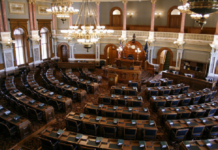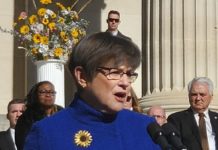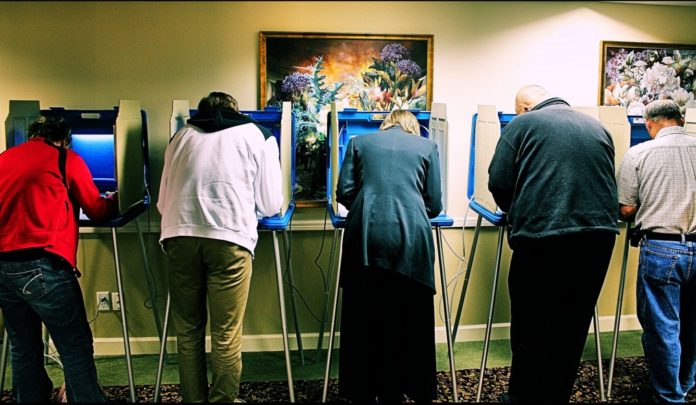(Updated to include comments from the ACLU, the attorney general with edits throughout).
A federal judge has upheld the constitutionality of a nearly 60-year-old Kansas law establishing a 250-foot buffer area to prevent electioneering at polling places.
U.S. District Judge Holly Teeter dismissed the lawsuit brought by the American Civil Liberties Union, which argued the law violated the constitutional right to free speech.
ACLU legal director Lauren Bonds said she is reviewing the order and will meet with the organization’s clients before deciding how to proceed.
Teeter upheld the Kansas buffer zone under a 1992 U.S. Supreme Court decision that found a Tennesse law with a 100-foot buffer zone was constitutional.
Teeter found the Tennessee case to be binding and “persuasive authority” for upholding the Kansas law.
The Supreme Court ruled in the Tennessee case that the evolution of election reform demonstrated the need for restricted areas around polling places to address increasing problems of voter intimidation and election fraud, Teeter wrote.
By 1900, most states, including Kansas, had adopted statutes banning electioneering near polling places, she wrote.
Kansas adopted its first electioneering statute in about 1893 when it established a 100-foot buffer zone.
The law was changed in 1965 to create a 250-foot buffer zone. Teeter said there are no government records explaining why Kansas expanded its buffer zone.
By the time the U.S. Supreme Court decided the Tennessee case in 1992, all 50 states limited access around polling places to some extent, Teeter said.
The Supreme Court concluded that “this widespread and time tested consensus demonstrates that some restricted zone is necessary in order to serve the states’ compelling interests in preventing voter intimidation and election fraud,” Teeter’s opinion stated in quoting the Tennessee case.
She noted in her opinion that the Supreme Court found that “the link between ballot secrecy and some restricted zone surrounding the voting area is not merely timing – it is common sense.”
She dismissed arguments raised by the plaintiffs, who contended that the state failed to justify the size of the buffer zone, the buffer zone was overly broad and the area was not narrowly tailored to justify the state’s interests.
The plaintiffs argued the size of the buffer zone was not justified by the state, something they argued was a central point in the Tennessee case.
“The Court disagrees with plaintiffs that (the Tennessee case) tied the constitutionality of a buffer zone to its size, or that it required any specific justification for a particular size of buffer zone,” Teeter wrote.
Teeter said the Supreme Court rejected any “litmus-paper test” to distinguish valid state election laws from invalid ones, she wrote.
The plaintiffs argued there were two federal appeals court cases from Kentucky that should apply in Kansas, one decision setting aside a 500-foot buffer zone and another rejecting a 300-foot buffer zone.
The court found that both cases were distinguishable from Kansas.
Teeter said the Kentucky buffer zone has been expanded over the years to 500 feet for reasons unrelated to preventing voter intimidation and fraud.
She said the Kentucky buffer zone had been expanded from 50 feet to 500 feet in 1987.
She said evidence in the record suggested that the 500-foot buffer zone had been passed specifically to eliminate as much electioneering in the entire state as possible, and for reasons largely unrelated to preventing voter intimidation and voter fraud.
“The circumstances in those cases were distinct, and the rationales in those cases are not applicable here,” she said.
She noted that the Kansas buffer zone was smaller than two that were struck down by the U.S. Sixth Circuit Court of Appeals
“Kansas’s electioneering law has also stood unchallenged in its current form for nearly 60 years – a characteristic of most buffer-zone laws that (the Supreme Court) specifically cited to excuse states from having to put on specific proof of justification.”
“Although plaintiffs argue that (the Kentucky cases) stand for the proposition that any buffer zone larger than 100 feet must be justified beyond the ‘historical’ and ‘common sense’ reasons outlined in (Tennessee), the court disagrees,” she wrote.
Kansas Attorney General Derek Schmidt praised the decision.
“I appreciate Judge Teeter’s ruling that the Constitution permits, and history and common sense favor, these sorts of laws that preserve the right to vote and ensure the integrity of Kansas elections,” Schmidt said.
“These laws permit all eligible voters to make their voices heard without intimidation, which goes to the heart and soul of our democratic process.”
The ACLU said the Kansas buffer zone is one of the largest in the country around any polling place.
It said the Kansas law is the only one in the country that does not exempt private property located within the boundaries of the buffer zone.
Teeter rejected the argument that the law was too broad because it encompassed private property.
“But even accepting – as the Court does for purposes of argument only – that electioneering buffer-zone laws are unconstitutional as applied to private property, this potential application does not demonstrate that the law punishes a substantial amount of speech in relation to its plainly legitimate scope.
“Just because a statute may encompass some impermissible application does not cause it to be constitutionally overbroad.”













